

Home
Shirenewton.Org
The villages
Shirenewton
Mynyddbach
Visitor information
Pubs and
Hotels
Places to stay
Monmouthshire
Wales
Local information
ShirenewtonChurch.com
St Thomas
Village fete
Schools
Clubs and societies
Village halls
Local businesses
These pages are dedicated to the memory of
Peter Hesketh.
How to play Piggy
Introduction
Regrettably, the origins of the charming game of Piggy are lost to antiquity. If anyone has thoughts on the roots of the game please contact me and I will update this note. I can be reached at madacres1@gmail.com
It is most likely one of the hundreds of rural games which can be played in the outdoors with a minimum of equipment, and may well be known in different parts of the world by different names.
It was taught to me by a university friend called David Smith who played it as a child growing up near Clitheroe in Lancashire. I should add that he always called the game Piggy not Piggies and I propose to retain this.
2 Equipment Needed
One of the charms of the game is that one can get started by taking a trip to any hardware shop and purchasing a couple of broom handles. (We stole our first ones from a college cleaning cupboard.)
Fashion the number of Pigs you need, a minimum of 1 each, plus some Spare Ribs, (Pigs tend to hide in long grass) by chopping about 3¼” from your broom handle and fashioning it as shown below. The flat underneath is a useful feature, as without it Pigs like to roll about, particularly if there is any mud nearby.
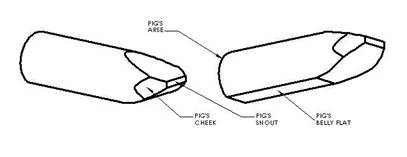
The dimensions are not important but all Pigs should be similar in size. If you are fussy, here are some dimensions that seem to work.

When you have made as many Pigs as you need, cut the remaining handles down to about 700mm to make a pair of Pig Stickers. (Keep any off-cuts for more Spare Ribs at some future date.) Some people prefer to form an angled flat on the striking end of the Sticker to help with the contact.
Pig customisation is warmly encouraged and can take the form of painting on a tail, eyes and ears, and the all-important name.
The last thing you need is a nice clean brick and this is known as the Sty.
3 Outline of the Game
Piggy is essentially a hit-and-run game for 3 or more players (the barmier, the better) in a wide-open space.
The Pig is placed on the Sty and rapped sharply on its snout using the sticker. This causes the Pig to jump in the air, and is called the Oink. While the Pig is airborne, it can be struck with the Sticker and caused to fly some considerable distance, this is called the Squeal. The next step is to estimate the number of running leaps that the next player in turn (called the Trotter) will need to make in order to cover the distance from the Sty to the landing site. This is called the Trotting Challenge and leads to the allocation of points. More of this later. (“He” is used throughout in this note and is genderless; the game being equally unsuitable to both sexes.
4 The Rules of Piggy
- The game is started with a Sounder. All players form a circle and a Pig is then spun and allowed to fall inside the circle. The player the Pig most closely points at becomes the first Sticker and begins the game.
- The first Sticker places his Pig on the Sty and is allowed 3 attempts to perform the Oink and Squeal.
- When the Sticker makes contact with the Pig, however lightly, an Oink is deemed to have taken place. An Oink so poorly judged as to land squarely on the Pig’s back is cruelty, and is met with cries of “shame” and general booing.
- There can be no Squeal without an Oink.
- If the first Squeal results in a distance that the Pig Sticker deems to be unacceptably footling, he may Rasher it. When a Squeal is Rashered, the Sticker collects his Pig, gives it a stern talking-to, and replaces it on the Sty for his second attempt. A single Rasher at the start of a turn carries no penalty.
- If the Sticker goes on to Rasher his second Squeal, he places himself at risk of a penalty. Should his third and final attempt prove unsuccessful, that is to say there is either no Squeal or the Pig lands within a distance that the Trotter could cover in a single leap from the Sty, the Sticker suffers a Full English. This amounts to awarding 10 points to all other players, and is accompanied by merciless humiliation and gleeful schadenfreude.
- There is no restriction on direction of Pig-flight and the onus rests with all non-stickers to be responsible for their personal safety.
- The game continues until a player reaches 51 points and this completes a Gammon. The complete Piggy session is called a Crackling and may comprise any agreed number of Gammons, and may be limited by a time constraint.
- At the end of each Gammon, the winning player is rewarded with the traditional applause with attendant porcine noises from all other players.
- Responsibility for Pig finding rests firmly with the Sticker. Stickers are generally advised to monitor Pig-flight very closely and carefully note the landing site. Searching for Pigs is boring and the Sticker who cannot locate his Pig is not to be trusted and is out of the Gammon (but not necessarily the Crackling) and his point tally is divided evenly between the remaining players.
5. Scoring at Piggy
The scoring system may be best understood by working through the following example:
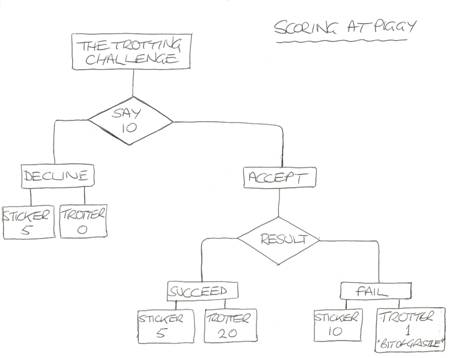
- After a successful Squeal, the Spotter (another player who is not the Trotter) goes to the landing site and raises his arm to indicate that the Pig is found, is healthy and happy in the mud, and that he is standing over it. This is called the Pig Out.
- The Sticker then estimates the number of leaps that the Trotter (next player in turn) will need to reach the landing site, starting at the Sty. No run-up is allowed. This is the Trotting Challenge and is formally issued thus;
“You can’t trot that in X” - where X is the number of leaps of his estimate.
- The Trotter must now accept or decline the Challenge. If he declines it, the Sticker adds half the challenge to his points total, rounding down should this result in a ½ value. The Trotter gains no points and becomes the Sticker.
- Should the Trotter accept the Challenge, he begins his Trot with all of his launch foot behind the Sty and leaps off in the direction of the Pig with the hearty cry “Pig 1” followed by “2”, “3”, “4” etc for each leap until he reaches the Pig.
- A successful Trot is performed when the Trotter reaches the Pig in a number of leaps equal to or less than the Challenge. The Spotter then calls “Chops” and points equal to twice the Challenge are added to the Trotter’s score. The Sticker gains points equal to half the Challenge as reward for being generally ballsy.
- If the Trot is greater than the Challenge, the Spotter calls “Belly Up” and the Sticker is awarded the full challenge. The Trotter gains “a bit of gristle” equal to 1 point by way of consolation after his noble endeavour.
- For the leap to count, the Spotter must be satisfied that some part of the foot at the point of landing was past the Pig. The Spotter’s judgement is unimpeachable and his decision is final. Challenging a ruling is at once undignified and pointless and is not in the spirit of Piggy.
6 General
- It is surprisingly difficult to achieve a successful Oink + Squeal. The best tip for beginners is to try and slow the whole process down. Pigs can be truculent and respond better to kindness and reward than aggressive behaviour.
- A canny and experienced Sticker may use the Pig Out of a novice Spotter as a guide to his Trotting Challenge. Practised Spotters quickly learn to obfuscate their Pig Out with changes in pace, silly gait and other amusing antics.
- The “no run-up” law is included to minimise dispute but players may decide by mutual consent to allow the run-up if they feel it adds to the fun.
- The game is best played as individuals as this necessarily rotates the task of Spotter and leads to fewer questionable judgements. If there is a large number of players however, teams work perfectly well. Piggy can be played with 2 but it is tricky without a Spotter.
- The player with most Gammons at the end of the Crackling is nominated “The Complete Swine” and is called upon to make a very short speech and buy the first round in the pub.
- Lastly, a plea that you give this delightful old game a bash and have as much fun playing it as we have. A few photographs of the equipment are shown to the right, and do not hesitate to contact me if you have further questions.
Will Smith-Haddon
December 2008
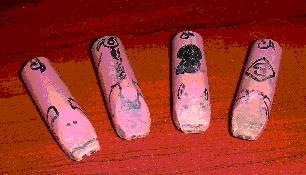
A Sounder of very experienced piggys
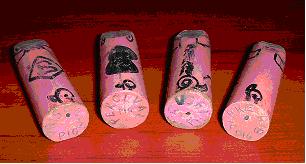
Priscilla, Percival, Professor and Spare Rib
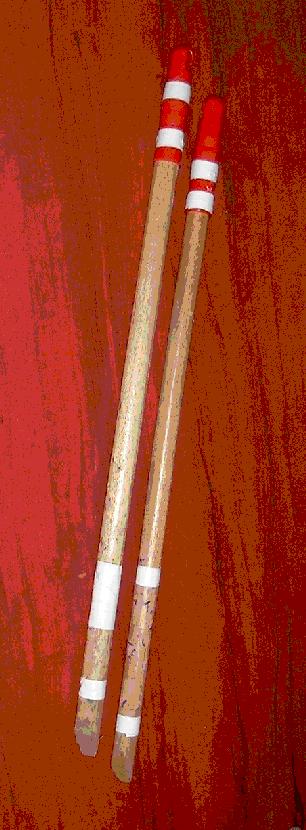
Stickers